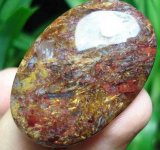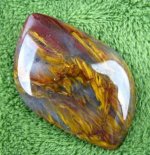C
Cappy Z.
Guest
Pietersite was discovered by Sid Pieters in 1962 while he was prospecting some farmland in Namibia, Africa. After his discovery, he registered the find in the mineral records of Britain. His discovery was published in 1964, and the material was named pietersite. Currently there are only two known sources of pietersite; China and Africa. These two forms of pietersite are similar but still somewhat different from each other. The Chinese pietersite's fibrous mineral is a magnesium-rich alkalic amphibole. The African (Namibian) variety is mainly crocidolite.
The China form of pietersite is said to have been discovered in 1993, but did not come to market until 1997. This China pietersite exhibits slightly different color variations from Mr. Pieter's original mineral, but both are beautiful and are now universally recognized as pietersite.
The material found in China was formed from a mineral very similar to crocidolite, named torendrikite. Chinese pietersite has striking combinations of gold, red and blue color segments which sometimes also includes a deep golden brown color. Regardless of the source, pietersite will always have brecciated, fibrous bands of blue, gold and/or red tiger eye type fibers in quartz. The fibrous structure in pietersite has been folded, stressed, even fractured and/or broken apart via the earth's geologic processes. The fibrous materials have then been reformed and naturally recemented together by quartz. Stones and crystals that go through this process are referred to as brecciated, creating a finished product with multiple colors, hues and superb chatoyancy.
Just bought this piece....I am obcessed...lol.
The China form of pietersite is said to have been discovered in 1993, but did not come to market until 1997. This China pietersite exhibits slightly different color variations from Mr. Pieter's original mineral, but both are beautiful and are now universally recognized as pietersite.
The material found in China was formed from a mineral very similar to crocidolite, named torendrikite. Chinese pietersite has striking combinations of gold, red and blue color segments which sometimes also includes a deep golden brown color. Regardless of the source, pietersite will always have brecciated, fibrous bands of blue, gold and/or red tiger eye type fibers in quartz. The fibrous structure in pietersite has been folded, stressed, even fractured and/or broken apart via the earth's geologic processes. The fibrous materials have then been reformed and naturally recemented together by quartz. Stones and crystals that go through this process are referred to as brecciated, creating a finished product with multiple colors, hues and superb chatoyancy.
Just bought this piece....I am obcessed...lol.










